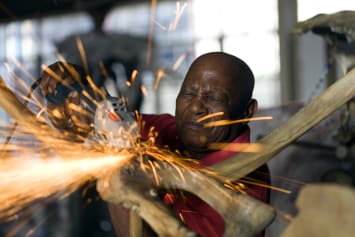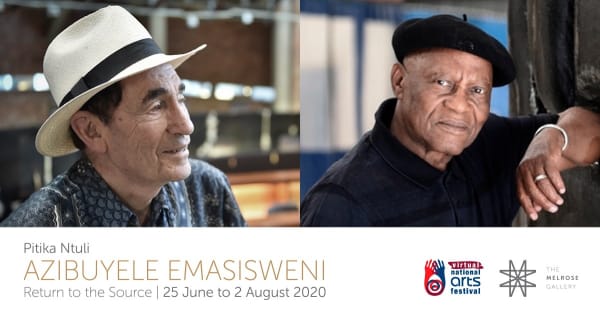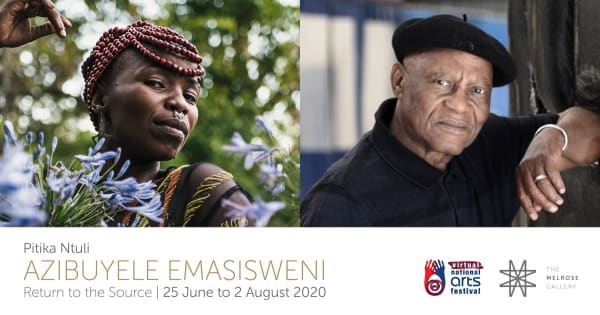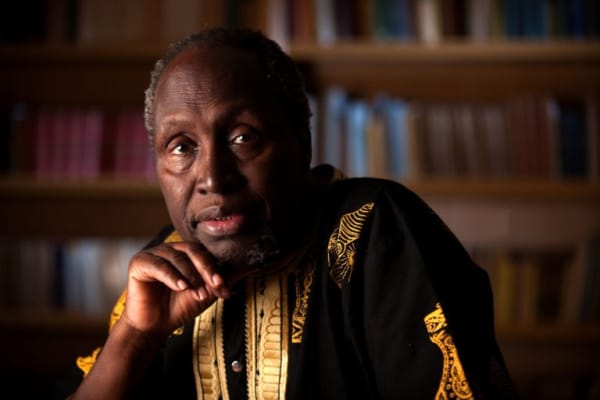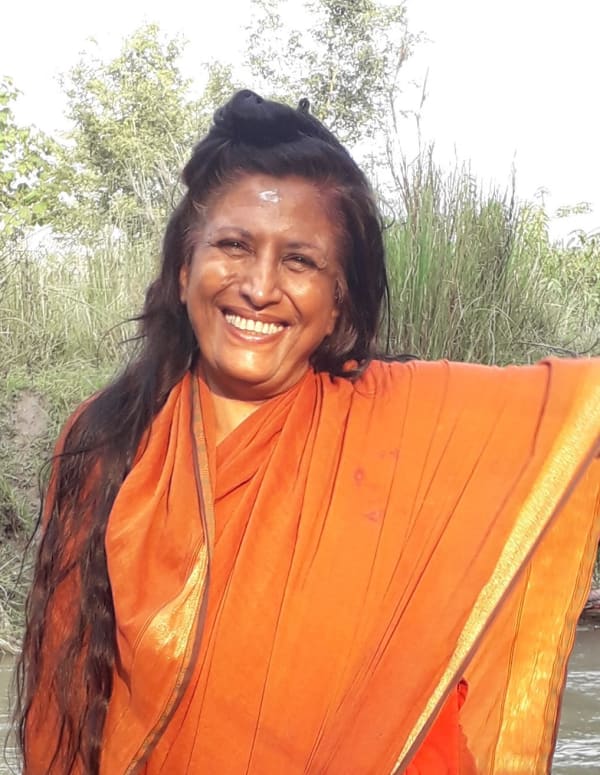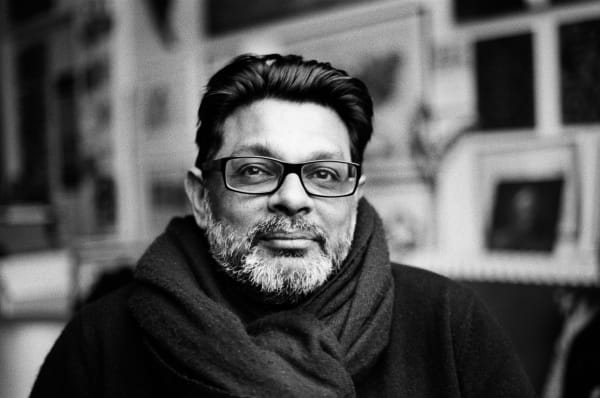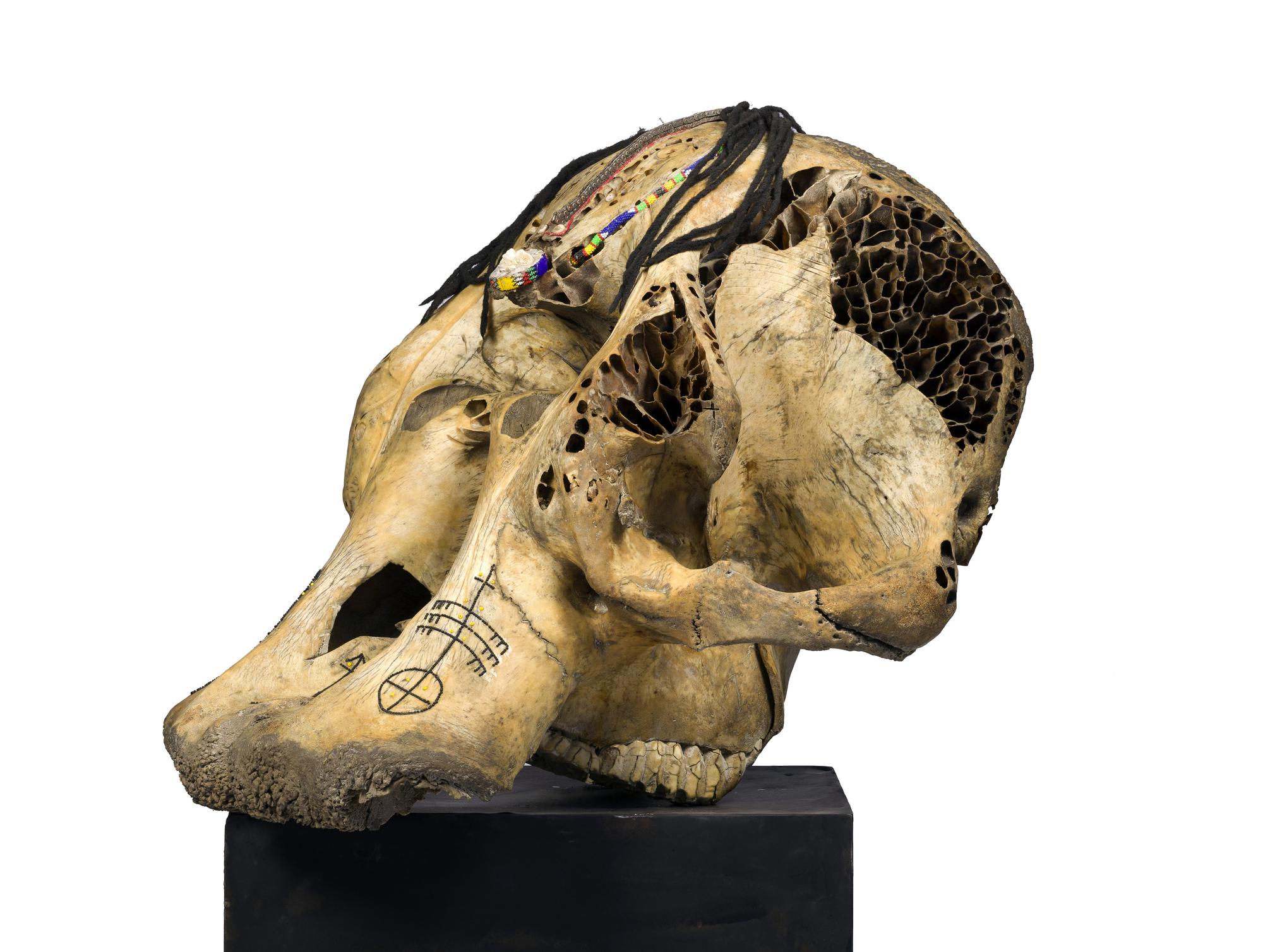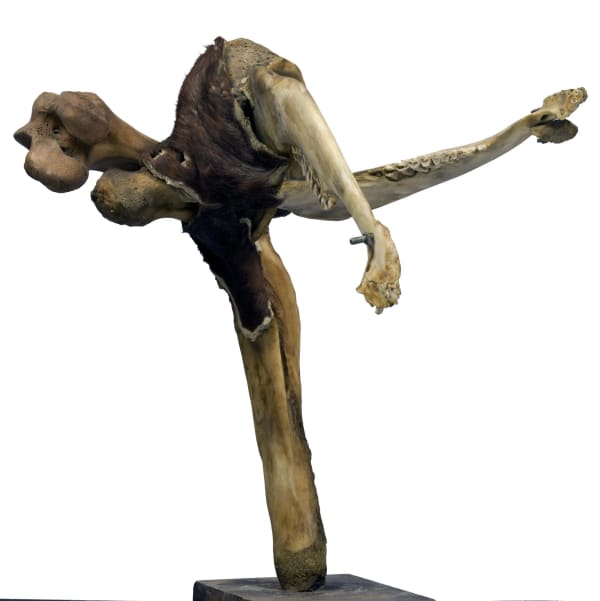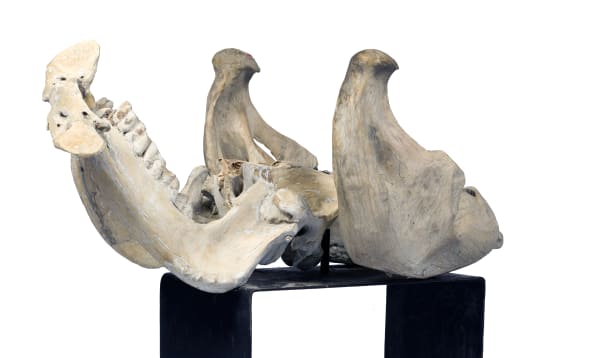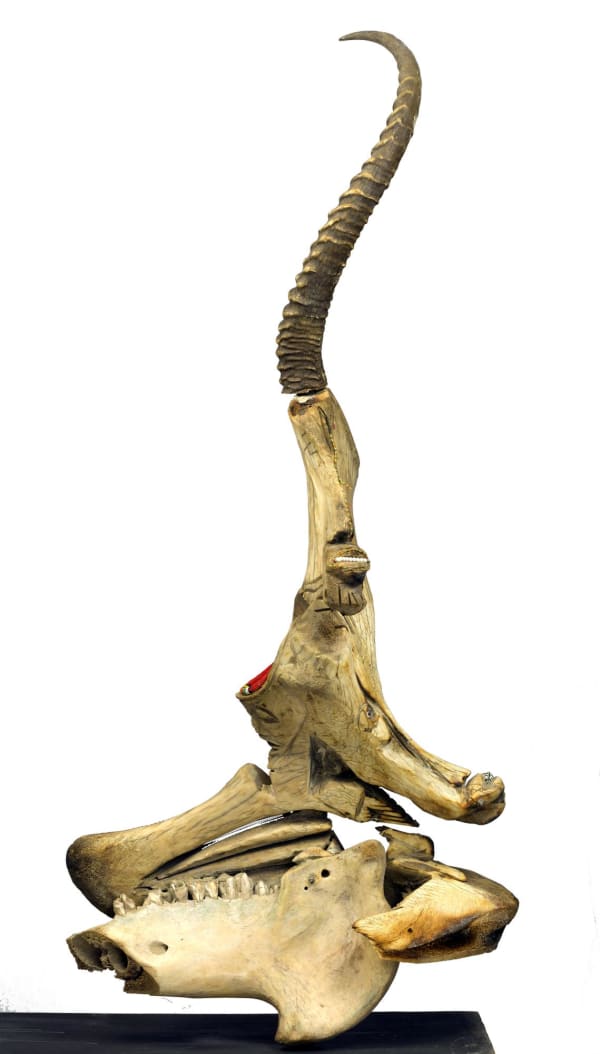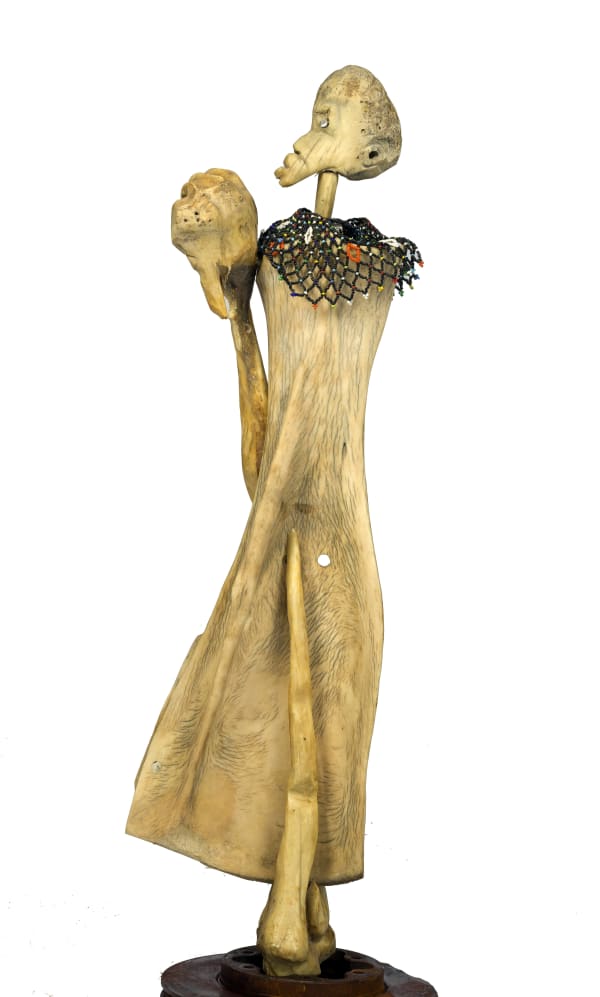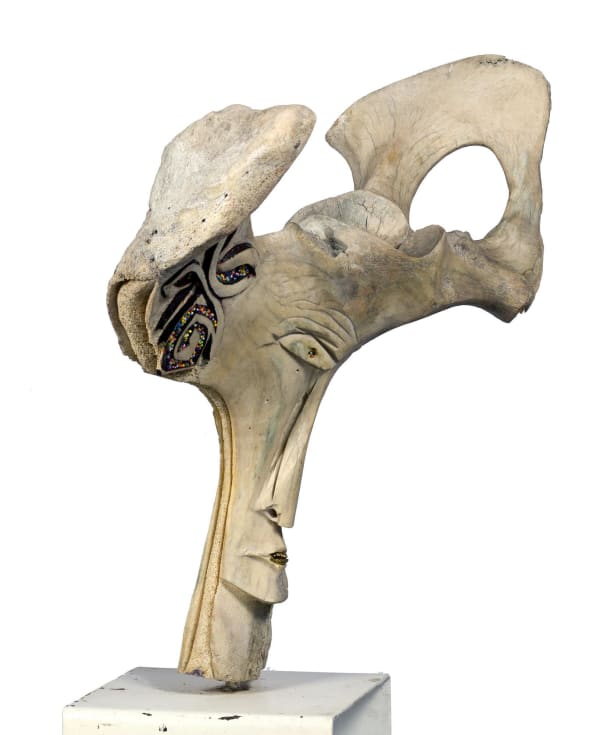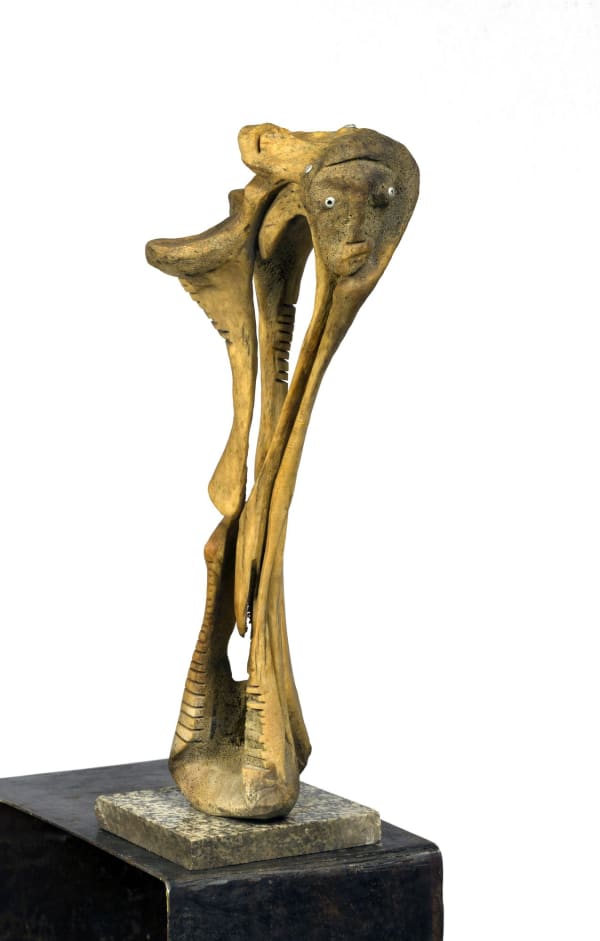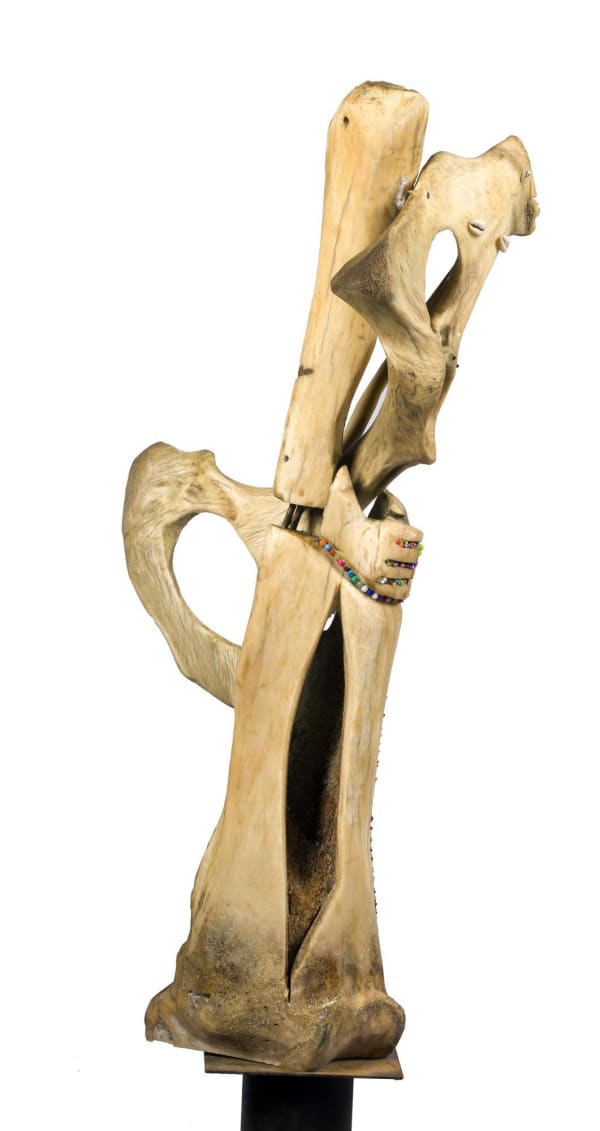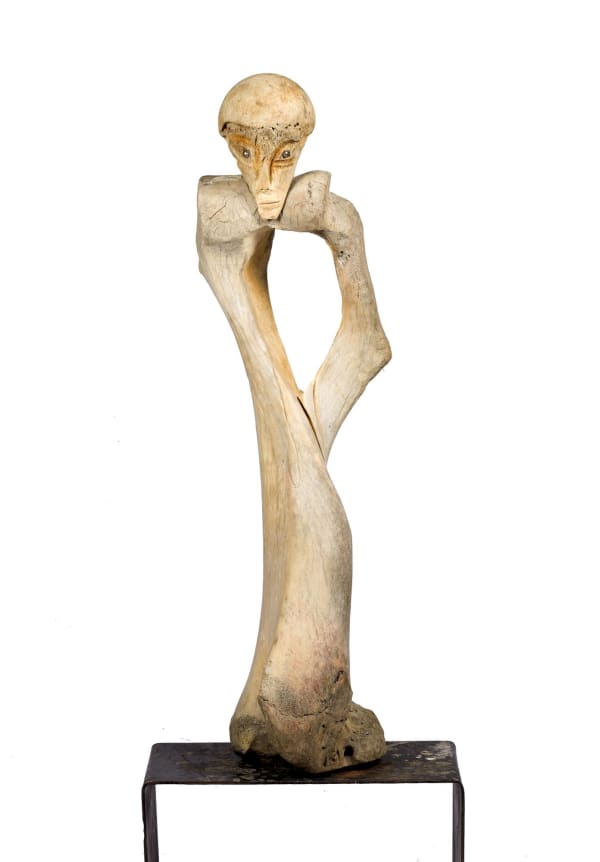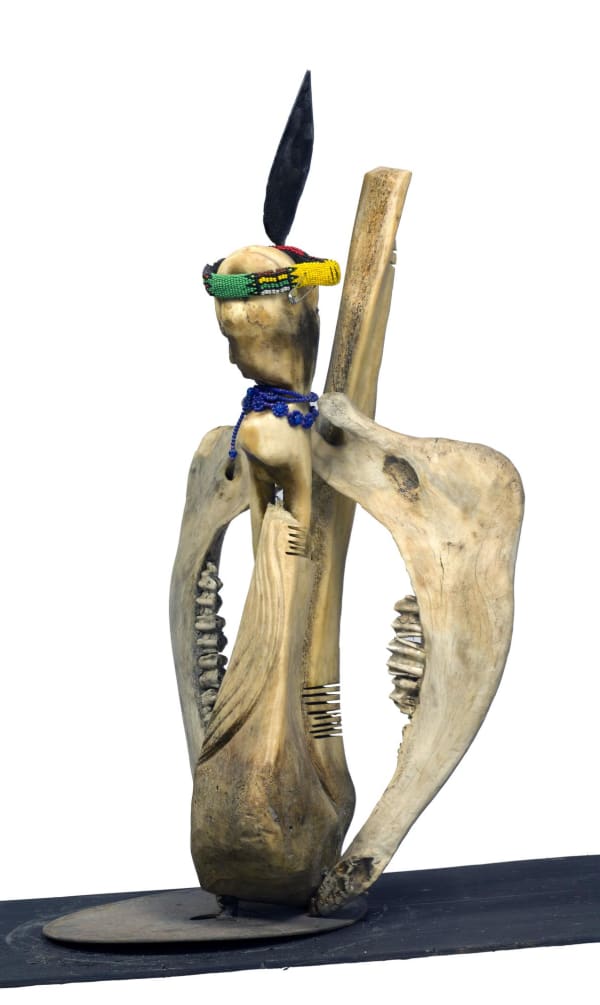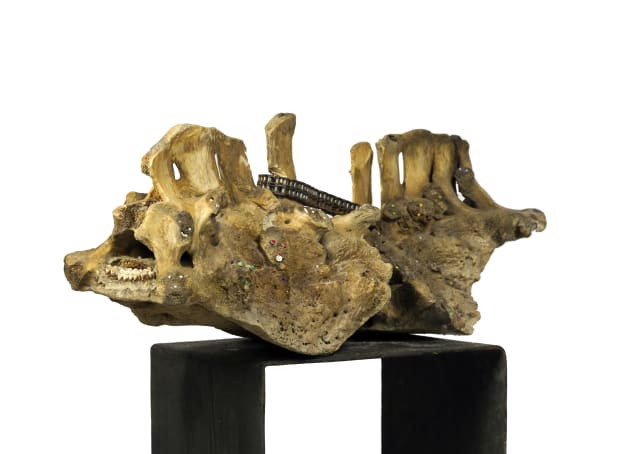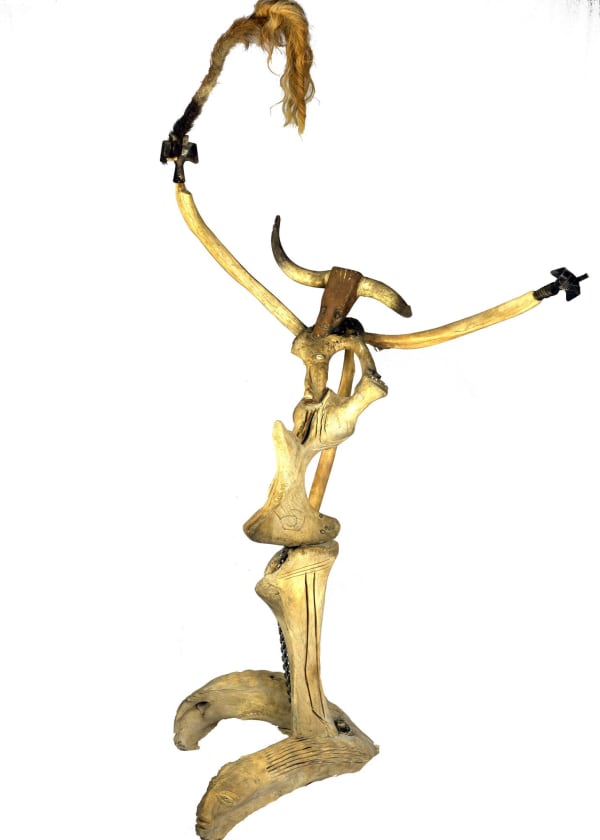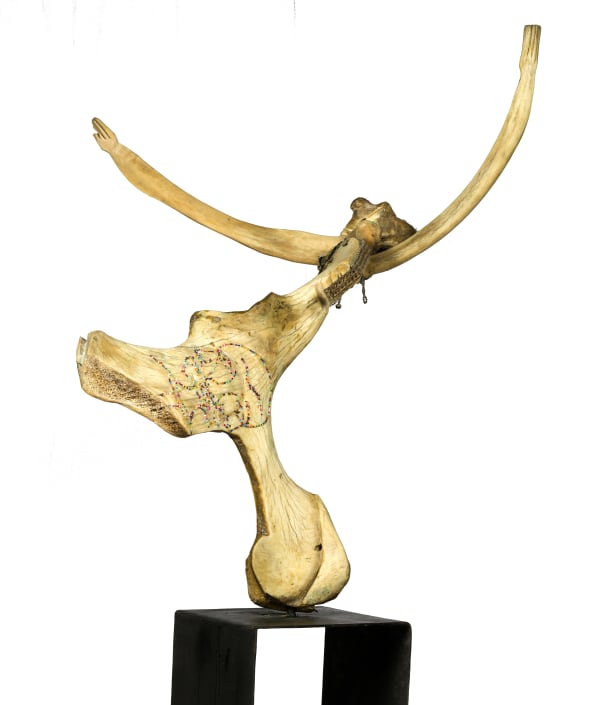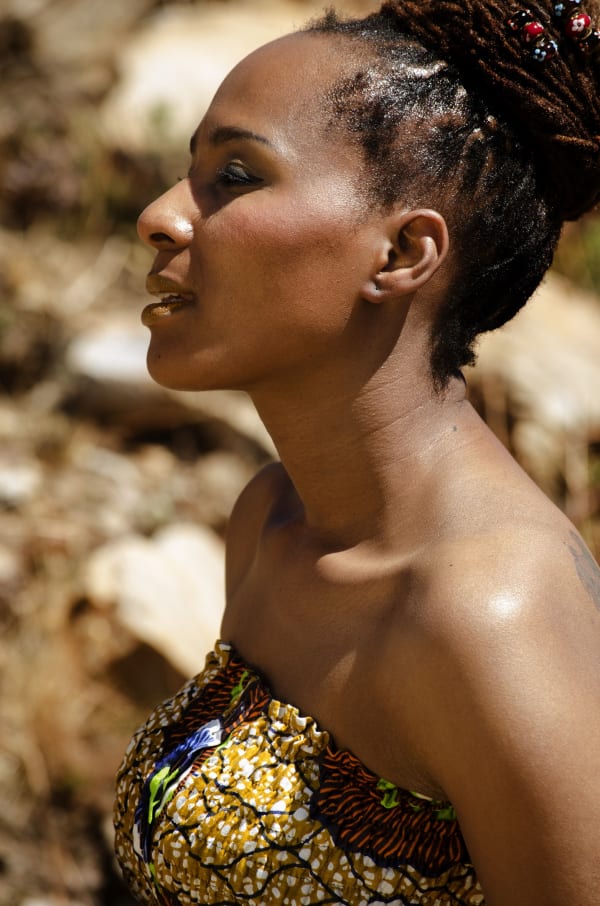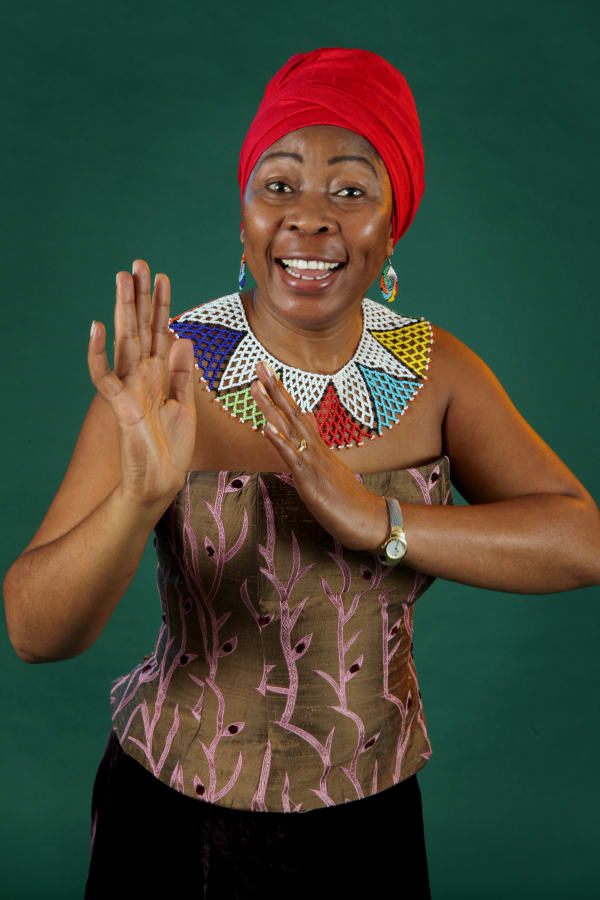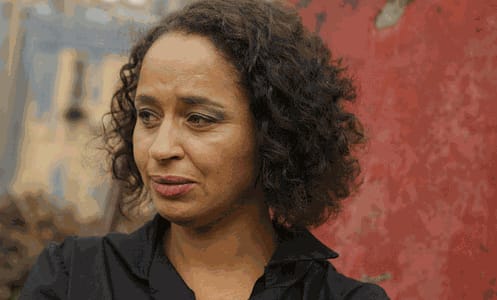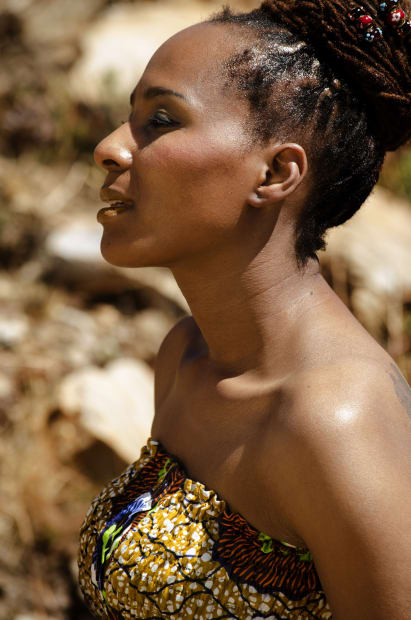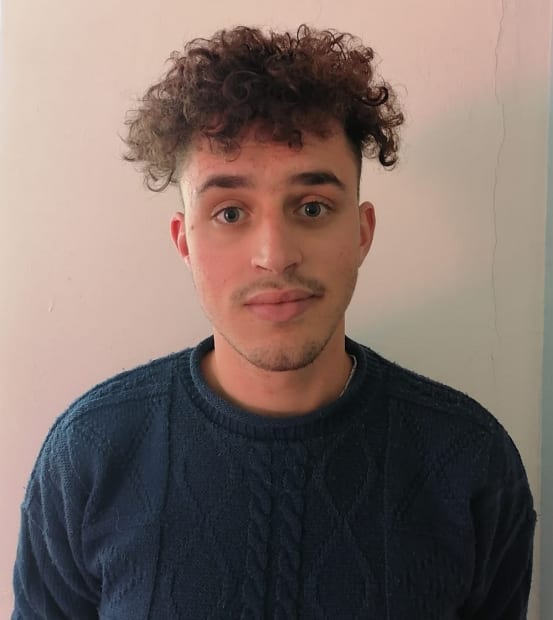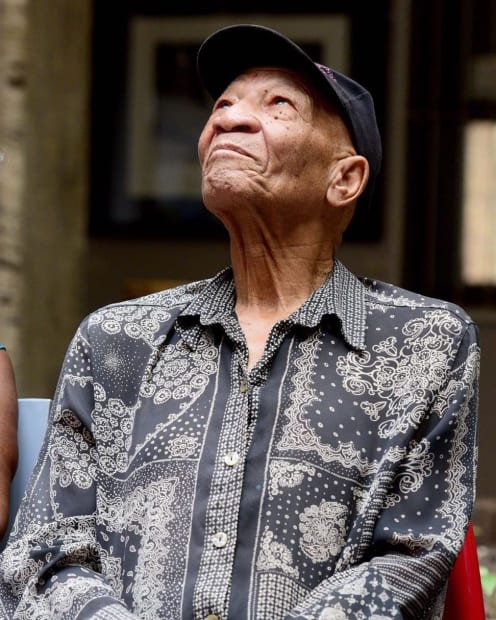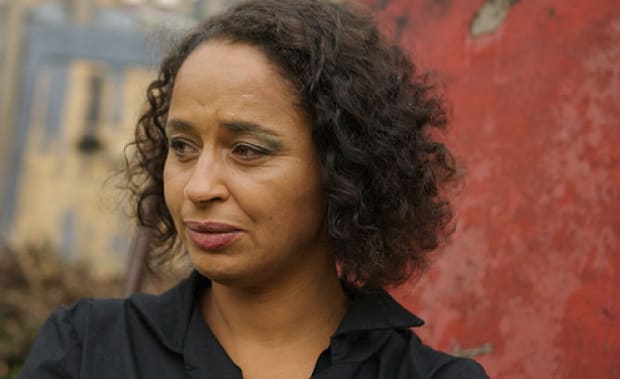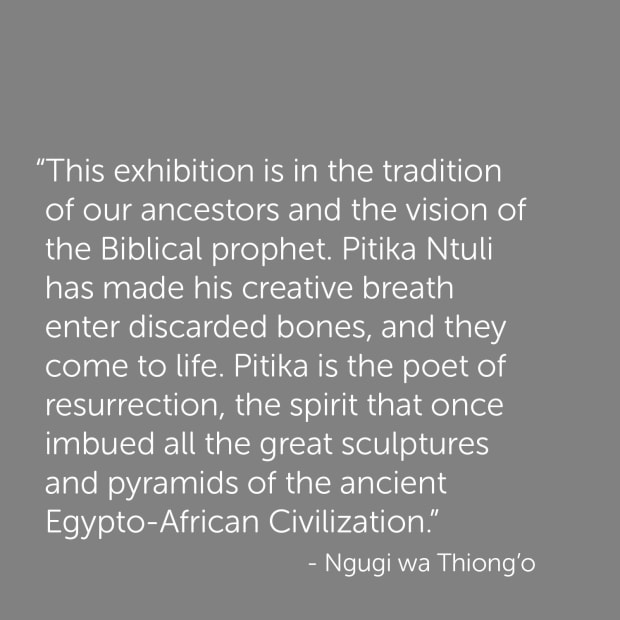"All pandemics seem to have one purpose, to strip people of their flesh leaving only bones! So we use our bones to heal. Our divinatory bones, and an angry abused earth are the catalyst underpinning this exhibition. I believe it is vitally important to focus people’s minds on healing in all its aspects at a time like this, and to emphasise that our common survival depends on us working collectively to both heal ourselves and the earth." - Pitika Ntuli
-
Pitika Ntuli’s acclaimed exhibition to tour SA museums.
Few online exhibitions grabbed attention during the height of Covid. Pitika Ntuli’s Azibuyele Emasisweni, (Return to the Source) stood out, for not only had the eighty-year-old artist produced 45 new sculptures from bones and other materials, but in relaying their full significance, some of the country’s most esteemed poets and musicians responded to the body of work with songs and poems. This made for an incredible online programme, however, as with all art, the works are best enjoyed in person. A national tour of Ntuli’s Azibuyele Emasisweni, which will show at Oliewenhuis Art Museum and then the Durban Art Gallery from October, will give the public a chance to appreciate these extraordinary works up close.
Azibuyele Emasisweni, (Return to the Source) was first opened at the National Arts Festival in June 2020 by Naledi Pandor, Minister of International Relations. It was part of the main programme of this arts festival and challenged fixed definitions of ‘contemporary’ and ‘traditional art’. The exhibition was curated by Ruzy Rusike.
-
UKUPHAHLA
OPENING AIRWAYS FOR THE ANCESTORS BY SESIYAKHULA NJALO -
-
Curatorial Statement
Ruzy RusikeThrough our tears, we can begin to plumb the depths of our inner being, helping us to understand the deepest questions of our lives, the journeys we are on, and our sense of belonging.
There is a sense of tranquillity and catharsis that we derive from crying. It resonates within and without, as the warmth of a tear falls onto our faces, touching our cheeks and then our lips. It is in these tears that we can understand the depth of our being and a realization of the answers to our lives’ deepest questions, along with a sense of belonging. Animals are embodiments of tranquillity as they live in harmony within it by constantly observing, assimilating, and being in stillness within themselves and without disturbance. As much as animals take from their environment, they give back to it constantly through their life cycle. Our cycle of giving back is at the end when our whole life form is placed into the earth and only our bones remain. Therefore, it is not by chance that Azibuyele Emasisweni (Return to the Source) comprises of works solely sculpted from animal bones. These bones are imbued with pure and natural energy in line with their attunement to the natural flow of the world. This contrasts humans, who remain within the energetic rhythms made by the intentions, will, and reactions of the communities we belong to. The bones that are on display in this exhibition represent both mortality and immortality: the transitory spirit of the animal. Azibuyele Emasisweni (Return to the Source) aligns the spirit to the bondless form of time.
SOURCE
Bones are the structure of what was once a life form. In semantics, the ‘bone’ is classified first as a noun and defined as ‘any of the pieces of hard whitish tissue making up the skeleton in humans and other vertebrates.’ In biology, it is defined as ‘the rigid organ comprised of bone tissues, and forms the skeleton of most vertebrates.’ While these English understandings are relevant, I will instead align this essay to its Nguni words, amathambo okubhula (divination bones). These are a set of bones used as a medium of communication between a traditional healer and ancestral spirits. That knowledge, whether it is indigenous or modern, is the outcome of model-making above the functioning of the natural world. All societies strive to make sense of how the natural world behaves. We strive to apply this knowledge that will guide practices which align with one’s social, religious, and cultural beliefs. Furthermore, the practice of exhibitions gives one a sense of range, reach, possibility, and what can be imagined when we platform an idea. As the word ‘platform’ comes from ‘plot’ and ‘form’, from stage and theatre, it suggests that there is a structure that can host other behaviours. Its exterior allows possible behaviours, while its interior stays relatively fixed – like different plays being performed in a single venue. Although the exhibition echoes existing ideas, there is a larger unfolding of messages that sets forth a new agenda when it comes to understanding the established knowledge systems of content, sculpture, spirituality, exhibition, and audience.
The Spirit
Pitika Ntuli identifies as an artist, academic polymath, political activist, struggle stalwart, poet, and spiritual healer – someone who embraces both the physical and spiritual aspects of humanity. In this body of 45 works, he has engaged in numerous collaborations with other thought-leaders in the arts, music, theatre, literature, politics, media, and performance. One gains a new-found understanding of oneself in a community of things, ideas, people, rituals, and languages. We can see this today, especially in this paradigm of COVID-19, Black Lives Matter, the internet, communication, and knowledge. We see his sculptural acts of divination to bind the spirit animal to the animal bone. We can see an act that aligns itself to the particular moment of a community that gathers around the interpretations of being. We consider what it is that they see or do not see: a community that grows around a concept. Thus, his works reverberate moments that have existed, currently exist, and shall come to exist. In other words, he collapses time through the act of activating the spirit of the bones by decorating them with symbols, beads, shells, objects, and hair which are relevant to the spirit of the bone that he wishes to call upon. Ntuli reconciles the chasm between the two - bone and spirit - by creating a space for the spirit of the animal to come into being. When communicated or brought to us, this spirit ceases to adhere to time but ties itself to the earthly plane that facilitates communication and allows us to draw from their qualities.
Historically, beads were traded for slaves as well as ivory, gold, and other goods distributed in Europe and around the world. Therefore, spiritual healers/izangoma treat and read beads as one of many connections to the ancestors. This symbiotic relationship can be read as the shackles that bound the ancestors to that of trade, conflict, slavery, life, death, and birth. The colours of the beads reflect the earth, air, wind, and fire – basic elements which align to meaningful symbolism.
Recently, Reverend Al Sharpton delivered a eulogy at the funeral of George Floyd that reflected the living part of a human in the afterlife of slavery of partus sequitur ventrem (that which is brought forth follows the womb):
Genesis II said that God formed man. And Jamie, they say he breathed breath, the breath of life to make him a live human being, which means that breath comes from God. Breath is how God gives you life. Breath is not some coincidental kind of thing that happens. Breath is a divine decision that God made. Some babies are born stillborn. God decides to blow breath in them. Breath is sanctified, breath is sacred. You don’t have the right to take God’s breath out of anybody; you can’t put breath in their body. But you don’t look at it that way because of your wickedness, principalities, darkness.
The word 'spirit' is derived from the Latin word 'spiritus', meaning breath, and healing implies a process of making something whole. Spiritual healing is concerned, literally and originally, with holistic breathing transformations. It connects itself to the beginning and the end: breath is that which bonds the earth-bound physicality to the fluid movement of the spirit. If breathing stops, one is declared dead. Because Sharpton connects “breath to God” and “God to sacred”, he reiterates the impure energies of humans who are not sacred but connected to it. Breath is the umbilical cord to many forms of experiences, intentions, and cultivations we witness through different flows of breaths. Ntuli, through the divination act of sculpting into the animal bones, is in alignment with the frequency of the soul of the breath of the earth. This breath occupies time, space, and construction. When, like George Floyd, breath inhabits that Fanonian “zone of non-Being”: wickedness, principalities, and darkness deform the sacredness of breath. That is why space and platforms are important: they give us insight into other narratives. More importantly, spiritual healing and spiritual healers have become even more important as they guide the process of making things whole again: rupturing the continued marked effects of apartheid, slavery, imperialism, colonialism, and more.
The Complexity
The direction of time has changed: we no longer see ourselves as living in a linear sense of time, in the sense of the past being followed by the present and then the future. Rather, the future happens before the present and time arrives from the future. This must be addressed because terms such as ‘primitive’ and ‘contemporary’ art were defined according to a linear understanding of time. Linear time is a concept which many Africans reject, hence the phrase “You have African timing”. The interpretation of these works, therefore, is that of an unfinished project. More precisely, it is in the conditioning of what temporality or contingency does with these works within our traditional interpretations of ‘primitive’ and ‘contemporary’ art. The future is trading algorithmically, seven-year plans, development proposals, military simulations, securitised promotions, economic forecasts. All these predictions seek to extract, mine, and trade on the future. What emerges from this is that the 54 countries that assemble the continent of Africa have never been the object of what we call the ‘futures industry’. This is an industry whose network apparatus, and whose devices aim, to develop or stage its laboratory of prefatory futures in Africa. Therefore, this exhibition ignites a new consciousness through human, nature, and animal coming together as one.
It is important to note that the term Afrofuturism in the last decade, has been criticised by many artists and critics. The fact the prefix of Afrofuturism remains focused on the cultural practices of the African diaspora has come under particular fire. Being in the UK, USA, and Europe, the term effectively ends up excluding the history and the future theories and practices produced by artists and theorists working in East, West, North and South African, the Caribbean, and South America. This means the ‘Afro’ in Afrofuturism is still American and Anglo-centric. It is the non-African attempt to monopolise theories around blackness.
There is, therefore, a lot of difficulty in defining or terming a moment in African art or how art is produced in Africa. As most of the works being sculptures, paintings, ceramics, and land art, they evolve and react to time. Furthermore, terms such as ‘Primitive’, ‘Contemporary’, or ‘Afrofuturism’ find problems to narrate this ongoing transformation. This art communicates consumption, industry, technology, taxation, labour, warfare, finance, insurance, government, bureaucracy, science, religion, and philosophy – all of this together was made possible by the ubiquity of slavery. Thus, we bond these works to concepts that are not our own. Because of this complexity, one will never be able to say with certainty when blackness started: before or during the sugar revolution? Or whether slavery followed from racism or whether racism follows from slavery? These works help us realise that we need to examine what they evoke in us as humans and the level of consciousness they activate.
Return
Through our tears, we can begin to plumb the depths of our inner being, helping us to understand the deepest questions of our lives, the journeys we are on, and our sense of belonging. The combination of air, fire, earth, and water is what gives us this breath of life. The act of Breathing is sacred and pure. It is our gift to ourselves. Bones carry the very essence to our life form after transcendence into spiritual beings. Bones are what remains of us on this physical plane. Through this transitory life form, bones transform to become the source. Tribute must be given to Pitika Ntuli as he has allowed us to go into his innermost source through Azibuyele Emasisweni (Return to the Source).
-

-
Following in the tradition of the ‘Renaissance Man’, Pitika Ntuli is a true artistic, political and academic polymath. Interested in exploring the contradictory relationship between tradition and modernity, Ntuli’s witty and dark reflections on our society are captivating and visionary.
-
The Aesthetic Charge of Pitika Ntuli's Bone Sculptures
PANEL DISCUSSION 20 Aug 2020Click here to listen to the conversationFollowing the very successful talks program, we hosted on the 12th of August 2020 an online panel discussion titled The Aesthetic Charge of Pitika Ntuli's Bone Sculptures. The Panelists' included the following: Pitika Ntuli (Exhibition Artist), Ruzy Rusike (Exhibition Curator), Prof. Hlonipha Mokoena (Art Historian), Athi Mongezeleli Joja (Art Critic), Thembeka Heidi Sincuba (Artist), moderated by Thembinkosi Goniwe (Curator)
-
In Conversation
In this section we focus on a series of conversations that Pitika had with different leading thinkers around the exhibition.-

Exhibition opening address - Minister of International Relations Naledi Pandor
Click here to listen to the conversationMinister Grace Naledi Pandor is a South African academic, educationist, lecturer, and politician serving as the minister of International Relations and Cooperation since 2019. She has served as a member of parliament for the African National Congress (ANC) since 1994 and a member of the national Executive Committee of the African National Congress since 2002. She was Minister of Higher Education and Training from 27 February 2018 to 25 May 2019. Ms Grace Naledi Pandoor was the minister of science and technology of the republic of SA from 26 May 2014 until 26 February 2018.
-

Contextualizing the show - Curator Ruzy Rusike and Pitika Ntuli
Click here to listen to the conversationRusike is an artist, curator and a social activist she has curated many local and international exhibitions such as, Ubuntuism Re-chanted, Palazzo Bembo, Venice, Italy. This landscape. This landscape! The Quintessential Metaphor For Life Tribute Exhibition to David Koloane, RMB Turbine Art Fair. Alongside Thembinkosi Goniwe, The Art Africa Fair 2017, A Flagrant Arcade in Contemporary Art. Rusike was the curatorial researcher for the touring exhibition Towards Intersections: Negotiating Subjects, Objects and Contexts hosted at UNISA Art Gallery, Pretoria, Museum Africa, Newtown, Johannesburg and Gordon Institute of Business Science, Hyde Park, Johannesburg.
-

In conversation - Judge Albie Sachs and Pitika Ntuli
Click here to listen to the conversationAlbie Sachs, born in 1935, is a South African activist and a former judge of the Constitutional Court (1994 – 2009). In 1952, Sachs began his anti-apartheid activism by participating in The Defiance of Unjust Laws Campaign during the second year of his legal studies. In 1955, he attended the Congress of the People at Kliptown where the Freedom Charter was adopted, and, as an advocate, he worked to defend those charged under apartheid’s racist laws. As a result of his activism, Sachs was given banning orders that would restrict his movements and was also placed in solitary confinement for 168 days, without trial. His 22-year exile began in 1966, the first half of which was spent in England and the latter in Mozambique. In 1988, South African security agents pursued Sachs to Mozambique where they placed a bomb in his car, causing him to lose an arm and the sight in one eye.
-

In conversation - South African singer Zolani Mahola and Pitika Ntuli
Click here to listen to the conversationZolani Mahola is a South African Icon, Singer, Storyteller, Songwriter, and Actress. Zolani, ‘The One Who Sings’ believes in the transformative power of storytelling and that our central story about ourselves and our world changes our reality. Using words, music and her extraordinary theatrical background, she is a powerful advocate for connection. Connection to self, the natural world and to each other.
Profile of Zolani Mahola Image Credit: Gary Van Wyk
-

In conversation - Sociologist Ari Sitas and Pitika Ntuli | Part 1
Click here to listen to the conversationAri Sitas is a poet, dramatist, and sociologist. He was at the core of the transformation of Labour Studies, of popular, theater and musical work, and a range of cultural and educational initiatives in South Africa. He has recently been awarded the highest honor bequeathed to South Africans for his scientific and creative work, the Order of Mapungubwe. His latest work, Notes for An Oratorio for Small Things that Fall is published in 2020 by Tulika Press, Delhi and Columbia University Press.
-

In conversation - Sociologist Ari Sitas and Pitika Ntuli | Part 2
Click here to listen to the conversationAri Sitas is a poet, dramatist, and sociologist. He was at the core of the transformation of Labour Studies, of popular, theater and musical work, and a range of cultural and educational initiatives in South Africa. He has recently been awarded the highest honor bequeathed to South Africans for his scientific and creative work, the Order of Mapungubwe. His latest work, Notes for An Oratorio for Small Things that Fall is published in 2020 by Tulika Press, Delhi and Columbia University Press.
-

In conversation - Creative Monthati Masebe, Poet Felix Kobina Venter and Pitika Ntuli
Click here to listen to the conversationMonthati Masebe
Masebe is a pianist, composer and curator. Currently working as an archivist, she has access to multiple indigenous musical material from sub-saharan Africa. This along with her rich cultural childhood has shaped her compositions into interesting combinations of polyrhythmic ‘African’ structures and harmonies heavily inspired by impressionist/modernist composers who inspire her
Felix Kobina Venter's ProfileFelix Kobina Venter is an aspiring poet, writer and lyricist. He is currently studying at the Wits School of Film and Television. He has showcased with W.O.W, slammed on the Word n Sound stage and taken part in streaming events for Pick Me Up Poetry. He is just getting started.
Portrait image of Monthati Masebe by Neo Paulus
-

In conversation - Peace activist Ela Gandhi and Pitika Ntuli
Click here to listen to the conversationEla Gandhi, is a social worker and political activist in South Africa. She retired after serving two terms in the South African Parliament representing the ANC. Presently works in honorary capacity as Chairperson of Gandhi Development Trust and Phoenix Settlement Trust and is a co-President of Religions for Peace International, She has received 4 honorary doctorates from various Universities. In February 2020 she received the Papal Madallion from His Holiness Pope Francis.
-

In conversation - Debbie Golt, Pitika Ntuli, Eugene Skeef and Juwon Ogungbe
Click here to listen to the conversationDebbie hosts a unique encounter between long-standing friends and creatives Pitika Ntuli, Eugene Skeef and Juwon Ogungbe. They celebrate and unpack South African sculptor, poet, writer, and academic Pitika Ntuli's Azibuyele Emasisweni
-

Discussing the impact of Pitika Ntuli's award-winning Asibuyele Emasisweni (Return to Source)
Click here to listen to the conversationDebbie hosts distinguished sculptor, poet, Sangoma and academic Pitika Ntuli; composer, educator, singer and blogger Juwon Ogungbe; musician, poet and conflict resolution artist Eugene Skeef; actor, activist and writer Florence Matete; Head Curator Ruzy Rusike; and artist, curator, archivist Shaheen Merali.
-
-
In Art, the creative act is a titanic battle between flesh and spirit. Each artwork is a diversion of the flesh, the body. Each time the artist dies, a new work is born, or rather the opposite: each time a work of art is born the artist dies a little. A little death invokes a greater desire to live and thus creates another artwork. When the artist dies finally, she continues to live through her offspring – her children and her artworks! - Pitika Ntuli
-
Reflections and Essays
This section introduces various written texts produced by leading writers, musicians, curators and lectures in their respective fields of thought.-

Forward for the catalogue by Ngũgĩ wa Thiong’o
-

Preface text by Homi K. Bhabha
Snake and Lyre -

Essay by Prof. Pitika Ntuli
The Revenge of the Minkisi -

Catalogue entry by Lalitha Jawahirilal
-

Mr Buti Manamela Deputy Minister for Higher Education and Training
I carry my weapon -

Poet Antoinette Ntuli reflects Pitika Ntuli and his work
Your bones are under my skin -

Prof. Sophe Maithufi
Anthropomorphism at Large -

Journalist Ahmed Rajab
The Cosmology of Bones -

Artist, healer and improvisor Nduduzo Makhathini
Nduduzo Makhathini the Sonic Shaman: The Throwing of the Bones -

Artist and Curator Shaheen Merali
When an event becomes a lesson -

Poet-Musician Eugene Skeef
prophecy of the chosen one (for pitika ntuli – south african sculptor/poet)
-
-
The Sculptures
I am a healer: I throw bones to divine the State of the Nation in the season of anomie! - Pitika Ntuli -
 Pitika NtuliThohoyandou's Dream, 2018-2020Bone, beads and found objects84 x 87 x 101 cm
Pitika NtuliThohoyandou's Dream, 2018-2020Bone, beads and found objects84 x 87 x 101 cm -
Thoyohandou’s Dream
I hear your thunderous footsteps
Echo on the land of our ancestors
Thohoyandou, grandson of Dimbanyika
Father of Velembewu
Spirit that eternally caresses the Njelele valley
To keep ancestral forces at peace
Elephantine memories flow with ease and purpose
Retracing steps we took since time immemorial
To heal our bodies and souls
When demons invade our spaces
We carry memories of honeycomb
Of heroic histories in steady and secure
Geographies
Before interlopers walked our land
Spraying diseases to give purpose to their cures
We look back to retrace our odyssey
Along rugged roads of sickness and healing
To witness the birth of memory
-
-
Pitika NtuliMedium on Fire , 2018-2020Bone, beads and found objects175 x 95 cm
Medium on Fire
Prometheus stole the fire of the gods
Gave them to us to cook our food and light our caves!
I am a medium born from flames
Of memory and history
I dance you into health
Watched by the full moon
I am the warrior of the spirit
At war with pandemics
To appease the angry earth
Abused, polluted, pillaged and raped
Dance with me the ancestral dances
To heal our souls and those
Of those who drown in rivers
Of greed and corruption -
-
Pitika NtuliInside the Elephantine Womb of Memory, 2018-2020Bone, beads and found objects140 x 124 x 111 cm
Inside the Elephantine Womb of Memory
There we sat looking back at our beginnings
Nestled cozily inside a pelvic throne
Surveying the landscape of our dreams
Battlefields with nightmares of pandemics
Stretching endlessly before us across clear blue skies
And fresh flowing springs
Sweating on cold winter nights
Fingers tingling as we eat
Thirsty throats and vain attempts
To cough the virus out
We lift our arms
To drum health back into our bodies
Circling in prayer to invoke Ancestral voices
To intercede -
 Pitika NtuliSao Jose Paquette Africa, 2018 - 2020Bone, beads28 x 91 x 28cm(C002864)
Pitika NtuliSao Jose Paquette Africa, 2018 - 2020Bone, beads28 x 91 x 28cm(C002864) -
Pitika NtuliTrajectory of Po-To-Lo (Sirius B) on a Dragon Night , 2018-2020Bone and beads116 x 60 x 35 cm
Trajectory of Po-To-Lo[1] on a Dogon Night
We come from the
Planet of the red dog
I heard Credo Mutwa say
Even as the Dogon echoes hit my ears
We take our beaded paths
Dancing our way
To trace Po-To-Lo
Floating in infinite space
Riding on invisible boomerangs
We plot our return to the stars
The glittering stars
Of our birth!
[1] Sirius B
-
-
 Pitika NtuliThe Spirit of the Maroons, 2018-2020Bone and found objects150 x 52 x 90 cm
Pitika NtuliThe Spirit of the Maroons, 2018-2020Bone and found objects150 x 52 x 90 cmThe Spirit of the Maroons
We lift our arms to catch
Winds of change
Even as coronavirus pollutes the atmosphere
We invoke ancestral spirits
To speak in their healing language
From tongues of love!
They put us in biting chains
As they recited the pasternoster
Cotton fields stretching to the gates
Of eternity
We guard our freedom
With our lives!
-
Collaborators
-
Pitika Ntuli invited 33 thought and creative leaders to collaborate with him by creating content inspired by the sculptures and exhibition for inclusion on the online platform. Their engagements took the form of essays, poetry, film, song and an exciting talks programme. The exhibition speaks to indigenous knowledge systems and the importance of ‘Returning To The Source’. Whilst the exhibition was presented online the museum show would be the first time that audiences would have the opportunity to see this body of powerful works in person.
-
Collaborators
Video renditions of the collaborators contribution to the show-

Sibongile Khumalo
South African singerClick here to hear her contributionKhumalo was a South African singer. She sang classical, jazz, opera, and traditional South African music. She was noted for singing at the inauguration of Nelson Mandela in 1994, as well as the final of the Rugby World Cup the following year. She was appointed to the Order of Ikhamanga in 2008.
-

Zolani Mahola
South African Icon, Singer, Storyteller, Songwriter, and ActressClick here to hear her contributionZolani Mahola is on a new journey as The One Who Sings. Zolani Mahola believes in the transformative power of storytelling. She believes that our central story about ourselves and our world changes our reality. Using words, music and her extraordinary theatrical background, Zolani Mahola is a powerful advocate for connection. Connection to self, the natural world and to each other. -

Shaheen Merali
London based curator, critic and writer,Click here to hear his collaborationShaheen Merali is a curator, critic and writer, currently based in London. He explores the intersection of art, cultural identity and global histories in his work. Previously he was a key lecturer at Central Saint Martins School of Art (1995-2003), a visiting lecturer and researcher at the University of Westminster (1997-2003) and the Head of the Department of Exhibition, Film and New Media at the Haus der Kulturen der Welt, Berlin (2003-2008).
-

Napo Masheane
Creative Producer, Playwright, Poet, Performer| DirectorClick here to hear her collaborationNapo Masheane (Soweto/Qwaqwa) is one of South Africa’s leading multi-award-winning theatre makers, playwrights, producers, poets and directors. She holds a Master’s Degree in Creative Writing and has staged a number of plays both nationally and internationally. Among many, she has published three of her own poetry anthologies: Caves Speak in Metaphors (2007), Fat Songs For My Girlfriends (2011) and Heartbeat Of The Rain (2019)
-

Eugene Skeef FRSA
PercussionistClick here to hear his collaborationLondon-based South African percussionist, composer, poet, educationalist and broadcaster. Works in conflict resolution, acts as consultant on cultural development and teaches creative leadership. His innovative global projects include community music, jazz, ‘world’ music, European classical music, contemporary dance theatre and children’s storytelling.
-

Yvonne Chaka Chaka
South African singer, songwriter, actress, entrepreneur, humanitarian and teacherClick here to hear her colloborationYvonne Chaka Chaka is an internationally recognised South African singer, songwriter, actress, entrepreneur, humanitarian and teacher. Dubbed the "Princess of Africa" (a name she received after a 1990 tour), Chaka Chaka has been at the forefront of South African popular music for 27 years and has been popular in Nigeria, Zimbabwe, Kenya, Gabon, Sierra Leone and Ivory Coast. Songs like "I'm Burning Up", "Thank You Mr. DJ", "I Cry For Freedom", "Motherland" and the ever-popular "Umqombothi" ("African Beer") ensured Chaka Chaka's stardom. The song "Umqombothi" was featured in the opening scene of the 2004 movie Hotel Rwanda.
-

Dr Kwesi Owusu
Poet, film maker and authorDr Kwesi Owusu is a poet, film maker and author, with decades of experience working in the creative arts industry. His first feature film, AMA co - directed with Kwate Nee Owoo is acclaimed as a classic of magical realist cinema. He is the author of four books on the Creative Arts and culture, published by Routledge International and currently heads Creative Storm, one of Ghana’s leading communicators for social development in Accra.
Poem featured below
-

Gcina Mhlophe
South African anti-apartheid activist, actress, storyteller, poet, playwright, director and author.Click here to hear her collaborationGcina Mhlophe, born in 1959 in Hammarsdale, KwaZulu-Natal, has been writing and performing on stage and screen for over 20 years. She has written many children's books as well as adult audience poetry, short stories and plays. She produced and performed on a CD for children with Ladysmith Black Mambazo. She has written music for the SABC TV series Gcina & Friends where she performed her own stories for television audiences.
-

Juwon Ogungbe
London based musician, singer and composerClick here to hear his collaborationJuwon Ogungbe is an inspiring and well respected musician, singer and composer from London. Juwon’s concert and music theatre commissions include music for the Royal Shakespeare Company, Union Dance, the BBC, LIFT and the Southbank Centre amongst many others. In 2018, Juwon composed and performed new works in residencies at Opera North, Grimeborn Opera Festival, Dhow Countries Music Academy, Zanzibar and Longfield Hall, London amongst other settings. King Solomon and the Queen of Sheba – Juwon’s most recent music theatre piece, was premiered in 2019 and several new works of his have been publicly performed in 2020.
-

Felix Kobina Venter
Poet, writer and lyricistClick here to hear his collobrationFelix Kobina Venter is an aspiring poet, writer and lyricist. He is currently studying at the Wits School of Film and Television. He has showcased with W.O.W, slammed on the Word n Sound stage and taken part in streaming events for Pick Me Up Poetry. He is just getting started.
-

Shado Twala
South African journalistClick here to hear her collaborationShado Twala is a South African journalist, DJ, radio and TV producer, as well as an entrepreneur. She is best known for her work in some of South Africa’s popular radio stations including Radio Metro, former P4radio that was rebranded to Heart 104.9FM, 567 Cape Talk, and 702 Talk Radio. She is also popular for the work she has done as one of the judges on SA’s Got Talent since 2009. Currently, she also has the Shado Twala SAfm show called The World Stage.
-

Don Mattera
South African poetBorn Donato Francesco Mattera in 1935 in Johannesburg's Western Native Township (now Westbury), Don Mattera inherited multiple cultural traditions from his Italian grandfather, Khoisan/Xhosa grandmother and Tswana mother. Mattera was largely raised by his grandparents developing a strong affinity with Italy through his grandfather s reminiscences, Mattera has written of those reflections "I virtually lived in the farm cottage in his native Italy, and walked among the olive trees. Even my blood was shed in the long vendettas. I became one with them who I had never seen or touched or spoken to."
Poem featured below
-

PHILLIPPA YAA DE VILLIERS
South African writerClick here to hear her collaborationPhillippa Yaa de Villiers, born at Hillbrow in Johannesburg, is an award-winning South African writer and performance artist. The daughter of an Australian mother and a Ghanaian father, she was given up for adoption at nine months of age, although she was not told of it by her adoptive parents, a white family in apartheid South Africa, until she was 20 years old. She has commented that the negotiation of her situation has informed much of her writing. De Villiers studied journalism at Rhodes University, Grahamstown, and obtained a degree in Dramatic Art and Scriptwriting from the University of the Witwatersrand, South Africa. She is also a graduate of the Lecoq International School of Theatre in Paris, France, where she studied mime and theatre. Returning to South Africa in 1998, she worked as an actor for two years, before Bell’s palsy forced her to consider an alternative career in writing.
-

Bheki Gumede
Human rights activistClick here to hear to his contributionIs a managing director at the AfriCore Group, a governance consulting firm based in Johannesburg. He is a human rights activist with experience in Qualitative Research. He joined MM&A in 2001 and has since participated in executing election related projects in South Africa, Nigeria, Mozambique, Swaziland, DRC, Malawi, among others. He is a trustee of the Sankofa Arts Charitable Trust.
-

Prof Nalini Moodley-Diar
Executive Dean and Professor in the Faculty of Arts and Design at the Tshwane University of Technology, South Africa.Click here to view her collaborationNalini Moodley-Diar is currently the Executive Dean and Professor in the Faculty of Arts and Design at the Tshwane University of Technology, South Africa. She has a B.A (Fine Arts), M.A. (Art History) cum laude, a UPGCE and completed her PhD in Art History at the University of KwaZulu-Natal which focused on the visual art produced by Indian South Africans from 1961 to 1999. Her present areas of research include the politics of minorities as well as the complexities of race and identity politics within a transforming South Africa. She has published papers in peer reviewed journals on Hindu art and artists in South Africa, Indian dance, and the multiplicity of positionalities of Indians in South Africa. She is currently also engaged in research projects focusing on women leaders in higher education
-

Ahmed Rajab
International journalist, political analyst, essayist and a columnistClick here to hear his collaborationAhmed Rajab is a Zanzibari-born international journalist, political analyst, essayist and a columnist. A philosophy graduate (University of London), he also holds a post-graduate diploma in Urbanisation in Developing Countries (University College, London), and a Master’s degree in Modern African Literature (Sussex University). His dissertation was on the Négritude poet David Diop. Ahmed has worked for the BBC World Service, Index-on-Censorship, Africa Events, Africa Analysis, as well as Unesco and the UN OCHA. From 2006-2009 he was based in Dubai as Head of Newsroom (Middle East/Asia Bureau) for IRIN, the then UN humanitarian news agency, and he later spent another three years in Nairobi as Managing Director of Universal TV. He is currently the Strategic Director for the station. Ahmed’s poems are included in the anthology “African New Voices” (Longman, 1997). He has translated into Swahili two children books. Ahmed sat on the panel of judges for the 2019 Mabati-Cornell Kiswahili Prize for African Literature, the 2018 Caine Prize for African Writing and the 1999 CNN African Journalist of the Year Awards.
-

Ela Gandhi
Social worker and political activist in South Africa.Ela Gandhi, is a social worker and political activist in South Africa. She retired after serving two terms in the South African Parliament representing the ANC. Presently works in honorary capacity as Chairperson of Gandhi Development Trust and Phoenix Settlement Trust and is a co President of Religions for Peace International, She has received 4 honorary doctorates from various Universities. In February 2020 she received the Papal Madallion from His Holiness Pope Francis.
Poem featured below
-

Florence Masebe
South African actressClick here to hear her collaborationBorn and raised in Limpopo, South Africa. An actress, who is professionally trained actress whose been in the game for more than 20 years. Florence Masebe has made a mark in broadcasting and entertainment for more than 20 years, having worked in radio, film, and television both in front of the camera and behind the scenes. Some of her more prominent lead roles include work on popular dramas such as Generations, Muvhango, 7de Laan, Soul City, Inkaba, Scandal and Task Force. Across SA borders, she plays the lead role in Morwalela, a health drama on Botswana television. Miss Masebe made history at the Durban International Film Festival in 2020 as executive producer and star of the first ever professionally produced Tshivenda feature film Elelwani, which also go the honor of being the opening film of the festival. It is this role that won her the Best Actress in a led role accolade at the Africa Movie Academy Awards in 2013.
-

Simphiwe Dana
Singer-songwriterSimphiwe Dana is regarded as one of the best live performers in the global Jazz space. She has over 2 decades in the music industry. She is one of the artists that is vocal on topical issues such as politics and societal issues that affect the daily lives of South Africans. Simphiwe Dana sings timeless music and throughout her career, she has warmed many hearts. Known for her Afro-feminism voice, she is celebrated throughout the country for her feminism views, music and being a supporter of women on social media who turn to her for advice. This is how the angelic voiced Simphiwe Dana rose to fame.Poem featured below
-
-
Below you will find poems inspired by Pitika Ntuli's sculpture by the various collaborators
-

-

-

-

-

-

-

-

-

-

-
Moving Images
-
History written in Stone
Through Belfast Black Granite Pitika Ntuli tells a story. A story that attempts to capture the crucial steps in our revolutionary struggles. The six individual sculptures write our history in stone, and trace the painful steps we took towards finding justice in our beloved land!
Shot & Directed by Galerekwe Maimane & James Reynolds
Edited by Zee Ntuli
Music by Chris Letcher
-

-
Solitary
Art and solitary confinement carry the same birthmarks.” –Pitika Ntuli.This intimate short film provides the viewer with a personal insight into Pitika'smind and journey as an artist. He explains that art is like solitary confinement, where time seizes to exist, and that “Art exists in order to conquer time”.
Shot by Zee Ntuli & James Reynolds
Edited by Zee Ntuli
Sound design by Lorens Persson at Sterling Sound
Colourist Terry Simp
-
Reflections by Nduduzo Makhathini (Artist, Healer and Improvisor)
-
media
-
-

Pitika Ntuli Speaks To ART AFRICA In An All-Encompassing Conversation
2 May 2019The 77-year-old artist spoke to ART AFRICA in an all-encompassing conversation that touched on his origins as an artist, his favourite materials and the state of contemporary art in South... -

Pitika Ntuli’ hailed for his bone exhibition at National Arts Festival
Pitika Ntuli 3 Jul 2020Click here to enter the online exhibition Pitika Ntuli’s 45 bone sculpture exhibition receives high praise at the Virtual National Arts Festival. South African sculptor, poet and writer Pitika Ntuli’s... -

Azania Mosaka Speaks With Pitika Ntuli | 702 Radio
Azania Mosaka from 702 interviews Pitika Ntuli about his exhibition Azibuyele Emasisweni (Return to the Source), his first exhibition to comprise only of works sculpted in bone. The exhibition comprises...
-

